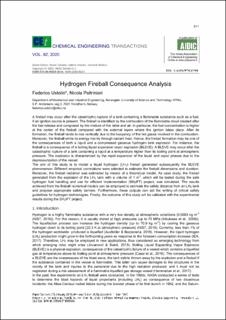| dc.contributor.author | Ustolin, Federico | |
| dc.contributor.author | Paltrinieri, Nicola | |
| dc.date.accessioned | 2022-05-03T12:22:45Z | |
| dc.date.available | 2022-05-03T12:22:45Z | |
| dc.date.created | 2020-11-18T10:48:57Z | |
| dc.date.issued | 2020 | |
| dc.identifier.citation | Chemical Engineering Transactions. 2020, 82 211-216. | en_US |
| dc.identifier.issn | 1974-9791 | |
| dc.identifier.uri | https://hdl.handle.net/11250/2993933 | |
| dc.description.abstract | A fireball may occur after the catastrophic rupture of a tank containing a flammable substance such as a fuel, if an ignition source is present. The fireball is identified by the combustion of the flammable cloud created after the fuel release and composed by the mixture of the latter and air. In particular, the fuel concentration is higher at the center of the fireball compared with the external layers where the ignition takes place. After its formation, the fireball tends to rise vertically due to the buoyancy of the hot gases involved in the combustion. Moreover, the fireball emits its energy mainly through radiant heat. Hence, the fireball formation may be one of the consequences of both a liquid and a compressed gaseous hydrogen tank explosion. For instance, the fireball is a consequence of a boiling liquid expansion vapor explosion (BLEVE). A BLEVE may occur after the catastrophic rupture of a tank containing a liquid at a temperature higher than its boiling point at atmospheric pressure. The explosion is characterized by the rapid expansion of the liquid and vapor phases due to the depressurization of the vessel. The aim of this study is to model a liquid hydrogen (LH2) fireball generated subsequently the BLEVE phenomenon. Different empirical correlations were selected to estimate the fireball dimensions and duration. Moreover, the fireball radiation was estimated by means of a theoretical model. As case study, the fireball generated from the explosion of the LH2 tank with a volume of 1 m3 , which will be tested during the safe hydrogen fuel handling and use for efficient implementation (SH2IFT) project, was simulated. The results achieved from the fireball numerical models can be employed to estimate the safety distance from an LH2 tank and propose appropriate safety barriers. Furthermore, these outputs can aid the writing of critical safety guidelines for hydrogen technologies. Finally, the outcome of this study will be validated with the experimental results during the SH2IFT project. | en_US |
| dc.language.iso | eng | en_US |
| dc.publisher | The Italian Association of Chemical Engineering (AIDIC) | en_US |
| dc.relation.uri | https://www.aidic.it/cet/20/82/036.pdf | |
| dc.rights | Navngivelse 4.0 Internasjonal | * |
| dc.rights.uri | http://creativecommons.org/licenses/by/4.0/deed.no | * |
| dc.title | Hydrogen Fireball Consequence Analysis | en_US |
| dc.title.alternative | Hydrogen Fireball Consequence Analysis | en_US |
| dc.type | Peer reviewed | en_US |
| dc.type | Journal article | en_US |
| dc.description.version | publishedVersion | en_US |
| dc.source.pagenumber | 211-216 | en_US |
| dc.source.volume | 82 | en_US |
| dc.source.journal | Chemical Engineering Transactions | en_US |
| dc.identifier.doi | 10.3303/CET2082036 | |
| dc.identifier.cristin | 1849143 | |
| dc.relation.project | Norges forskningsråd: 280964 | en_US |
| cristin.ispublished | true | |
| cristin.fulltext | original | |
| cristin.qualitycode | 1 | |

